Protective Effect of the Polysaccharides from Taraxacum mongolicum Leaf by Modulating the p53 Signaling Pathway in H22 Tumor-Bearing Mice
Abstract
1. Introduction
2. Materials and Methods
2.1. Materials
2.2. Preparation of DLP120
2.3. Design of Animal Model
2.4. Immune Organs Indices and Inhibitory Rates
2.5. NK Cells Activities
2.6. Splenic Lymphocyte Proliferation Activity
2.7. Peripheral Lymphocyte Subsets
2.8. Hematoxylin-Eosin Staining
2.8.1. Mice Solid Tumors
2.8.2. Mice Tumor Cells
2.9. Tumor Cell Cycle Assay
2.10. Annexin V/PI Assay
2.11. Reactive Oxygen Species (ROS) Determination
2.12. Western Blot (WB) Analysis
2.13. Statistical Analysis
3. Results and Discussion
3.1. Effects of DLP120 on Tumor Growth and Immune Organs
3.2. Effect of DLP120 on Activities of NK Cells
3.3. Effect of DLP120 on Splenic Lymphocyte Proliferation
3.4. Effect of DLP120 Peripheral Lymphocytes Subsets Distributions
3.5. Effect of DLP120 on Solid Tumor and Tumor Cells
3.6. Effect of DLP120 on Tumor Cell Cycle Distribution
3.7. Effect of DLP120 on Cell Apoptosis Detection
3.8. Effect of DLP120 on Reactive Oxygen Species
3.9. Western Blot Analysis
4. Discussion
5. Conclusions
Author Contributions
Funding
Data Availability Statement
Conflicts of Interest
References
- Papatheodoridis, G.V.; Dalekos, G.N.; Yurdaydin, C.; Buti, M.; Goulis, J.; Arends, P.; Sypsa, V.; Manolakopoulos, S.; Mangia, G.; Gatselis, N.; et al. Incidence and predictors of hepatocellular carcinoma in Caucasian chronic hepatitis B patients receiving entecavir or tenofovir. J. Hepatol. 2015, 62, 363–370. [Google Scholar] [CrossRef] [PubMed]
- Roudi, R.; D’Angelo, A.; Sirico, M.; Sobhani, N. Immunotherapeutic treatments in hepatocellular carcinoma; achievements, challenges and future prospects. Int. Immunopharmacol. 2021, 101, 108322. [Google Scholar] [CrossRef] [PubMed]
- Qiu, J.-J.; Wei, G.-F.; Du, J.-L.; Guo, J. Advances in the application of different anesthetic methods and drugs in interventional therapy for hepatocellular carcinoma. Clin. Res. Hepatol. Gastroenterol. 2022, 46, 101982. [Google Scholar] [CrossRef] [PubMed]
- Galdino-Vasconcelos, M.R.; Feijó, M.S.; Ferro, H.M.; Gomes, A.C.R.; De Almeida Santos, M.E.; Ferreira, G.; Jorge, F.; Trevizoli, N.; Diaz, L.G.; De Campos, P.B.; et al. Preoperative Alpha-Fetoprotein and Radiological Total Tumor Diameter as Predictors of Hepatocellular Carcinoma Recurrence After Liver Transplantation. Transplant. Proc. 2022, 54, 1333–1340. [Google Scholar] [CrossRef] [PubMed]
- McGlynn, K.A.; Petrick, J.L.; El-Serag, H.B. Epidemiology of Hepatocellular Carcinoma. Hepatology 2021, 73, 4–13. [Google Scholar] [CrossRef] [PubMed]
- Man, S.; Luo, C.; Yan, M.; Zhao, G.; Ma, L.; Gao, W. Treatment for liver cancer: From sorafenib to natural products. Eur. J. Med. Chem. 2021, 224, 113690. [Google Scholar] [CrossRef]
- He, X.; Wang, X.; Fang, J.; Chang, Y.; Ning, N.; Guo, H.; Huang, L.; Huang, X.; Zhao, Z. Polysaccharides in Grifola frondosa mushroom and their health promoting properties: A review. Int. J. Biol. Macromol. 2017, 101, 910–921. [Google Scholar] [CrossRef]
- Hu, C. Taraxacum: Phytochemistry and health benefits. Chin. Herb. Med. 2018, 10, 353–361. [Google Scholar] [CrossRef]
- Li, Y.; Chen, Y.; Sun-Waterhouse, D. The potential of dandelion in the fight against gastrointestinal diseases: A review. J. Ethnopharmacol. 2022, 293, 115272. [Google Scholar] [CrossRef]
- Choi, U.-K.; Lee, O.-H.; Yim, J.H.; Cho, C.-W.; Rhee, Y.K.; Lim, S.-I.; Kim, Y.-C. Hypolipidemic and Antioxidant Effects of Dandelion (Taraxacum officinale) Root and Leaf on Cholesterol-Fed Rabbits. Int. J. Mol. Sci. 2010, 11, 67–78. [Google Scholar] [CrossRef]
- Xiong, H.; Cheng, Y.; Zhang, X.; Zhang, X. Effects of taraxasterol on iNOS and COX-2 expression in LPS-induced RAW 264.7 macrophages. J. Ethnopharmacol. 2014, 155, 753–757. [Google Scholar] [CrossRef]
- Ren, F.; Wu, K.; Yang, Y.; Yang, Y.; Wang, Y.; Li, J. Dandelion Polysaccharide Exerts Anti-Angiogenesis Effect on Hepatocellular Carcinoma by Regulating VEGF/HIF-1α Expression. Front. Pharmacol. 2020, 11, 460. [Google Scholar] [CrossRef]
- Ren, F.; Li, J.; Yuan, X.; Wang, Y.; Wu, K.; Kang, L.; Luo, Y.; Zhang, H.; Yuan, Z. Dandelion polysaccharides exert anticancer effect on Hepatocellular carcinoma by inhibiting PI3K/AKT/mTOR pathway and enhancing immune response. J. Funct. Foods 2019, 55, 263–274. [Google Scholar] [CrossRef]
- Wang, L.; Li, L.; Gao, J.; Huang, J.; Yang, Y.; Xu, Y.; Liu, S.; Yu, W. Characterization, antioxidant and immunomodulatory effects of selenized polysaccharides from dandelion roots. Carbohydr. Polym. 2021, 260, 117796. [Google Scholar] [CrossRef]
- Tang, Y.; Zhu, Z.-Y.; Liu, Y.; Sun, H.; Song, Q.-Y.; Zhang, Y. The chemical structure and anti-aging bioactivity of an acid polysaccharide obtained from rose buds. Food Funct. 2018, 9, 2300–2312. [Google Scholar] [CrossRef]
- Ji, H.-Y.; Yu, J.; Liu, A.-J. Structural characterization of a low molecular weight polysaccharide from Grifola frondosa and its antitumor activity in H22 tumor-bearing mice. J. Funct. Foods 2019, 61, 103472. [Google Scholar] [CrossRef]
- Seidl, K.; Zinkernagel, A.S. The MTT assay is a rapid and reliable quantitative method to assess Staphylococcus aureus induced endothelial cell damage. J. Microbiol. Methods 2013, 92, 307–309. [Google Scholar] [CrossRef]
- Ren, Z.; He, C.; Fan, Y.; Si, H.; Wang, Y.; Shi, Z.; Zhao, X.; Zheng, Y.; Liu, Q.; Zhang, H. Immune-enhancing activity of polysaccharides from Cyrtomium macrophyllum. Int. J. Biol. Macromol. 2014, 70, 590–595. [Google Scholar] [CrossRef]
- Khramtsov, P.; Kalashnikova, T.; Bochkova, M.; Kropaneva, M.; Timganova, V.; Zamorina, S.; Rayev, M. Measuring the concentration of protein nanoparticles synthesized by desolvation method: Comparison of Bradford assay, BCA assay, hydrolysis/UV spectroscopy and gravimetric analysis. Int. J. Pharm. 2021, 599, 120422. [Google Scholar] [CrossRef]
- Paulusma, C.C.; Lamers, W.H.; Broer, S.; van de Graaf, S.F.J. Amino acid metabolism, transport and signalling in the liver revisited. Biochem. Pharmacol. 2022, 201, 115074. [Google Scholar] [CrossRef]
- Bronte, V.; Pittet, M.J. The Spleen in Local and Systemic Regulation of Immunity. Immunity 2013, 39, 806–818. [Google Scholar] [CrossRef] [PubMed]
- Thapa, P.; Farber, D.L. The Role of the Thymus in the Immune Response. Thorac. Surg. Clin. 2019, 29, 123–131. [Google Scholar] [CrossRef] [PubMed]
- Mamessier, E.; Sylvain, A.; Thibult, M.L.; Houvenaeghel, G.; Jacquemier, J.; Castellano, R.; Goncalves, A.; Andre, P.; Romagne, F.; Thibault, G.; et al. Human breast cancer cells enhance self tolerance by promoting evasion from NK cell antitumor immunity. J. Clin. Investig. 2011, 121, 3609–3622. [Google Scholar] [CrossRef] [PubMed]
- Singh, S.S.; Haldar, C.; Rai, S. Melatonin and differential effect of L-thyroxine on immune system of Indian tropical bird Perdicula asiatica. Gen. Comp. Endocrinol. 2006, 145, 215–221. [Google Scholar] [CrossRef] [PubMed]
- Tosato, F.; Bernardi, D.; Sanzari, M.C.; Pantano, G.; Plebani, M. Biological variability of lymphocyte subsets of human adults’ blood. Clin. Chim. Acta 2013, 424, 159–163. [Google Scholar] [CrossRef]
- Atilla, P.A.; Atilla, E. Resistance against anti-CD19 and anti-BCMA CAR T cells: Recent advances and coping strategies. Transl. Oncol. 2022, 22, 101459. [Google Scholar] [CrossRef]
- Kruse, R.L.; Shum, T.; Legras, X.; Barzi, M.; Pankowicz, F.P.; Gottschalk, S.; Bissig, K.-D. In Situ Liver Expression of HBsAg/CD3-Bispecific Antibodies for HBV Immunotherapy. Mol. Ther.-Methods Clin. Dev. 2017, 7, 32–41. [Google Scholar] [CrossRef]
- Sarmiento-Salinas, F.L.; Perez-Gonzalez, A.; Acosta-Casique, A.; Ix-Ballote, A.; Diaz, A.; Treviño, S.; Rosas-Murrieta, N.H.; Millán-Perez-Peña, L.; Maycotte, P. Reactive oxygen species: Role in carcinogenesis, cancer cell signaling and tumor progression. Life Sci. 2021, 284, 119942. [Google Scholar] [CrossRef]
- Assi, M. The differential role of reactive oxygen species in early and late stages of cancer. Am. J. Physiol.-Regul. Integr. Comp. Physiol. 2017, 313, R646–R653. [Google Scholar] [CrossRef]
- Khotimchenko, M. Pectin polymers for colon-targeted antitumor drug delivery. Int. J. Biol. Macromol. 2020, 158, 1110–1124. [Google Scholar] [CrossRef]
- He, F.; Zhang, S.; Li, Y.; Chen, X.; Du, Z.; Shao, C.; Ding, K. The structure elucidation of novel arabinogalactan LRP1-S2 against pancreatic cancer cells growth in vitro and in vivo. Carbohydr. Polym. 2021, 267, 118172. [Google Scholar] [CrossRef]
- Mohammadi-Motlagh, H.-R.; Sadeghalvad, M.; Rezaei, N. Organs and Tissues of the Immune System. In Encyclopedia of Infection and Immunity; Rezaei, N., Ed.; Elsevier: Oxford, UK, 2022; pp. 14–23. [Google Scholar] [CrossRef]
- Wang, L.; Kuang, Z.; Zhang, D.; Gao, Y.; Ying, M.; Wang, T. Reactive oxygen species in immune cells: A new antitumor target. Biomed. Pharmacother. 2021, 133, 110978. [Google Scholar] [CrossRef]
- Finn, O.J. Immuno-oncology: Understanding the function and dysfunction of the immune system in cancer. Ann. Oncol. 2012, 23, viii6–viii9. [Google Scholar] [CrossRef]
- Benne, C.; Lelievre, J.D.; Balbo, M.; Henry, A.; Sakano, S.; Levy, Y. Notch Increases T/NK Potential of Human Hematopoietic Progenitors and Inhibits B Cell Differentiation at a Pro-B Stage. Stem Cells 2009, 27, 1676–1685. [Google Scholar] [CrossRef]
- Niu, Y.-X.; Xu, Z.-X.; Yu, L.-F.; Lu, Y.-P.; Wang, Y.; Wu, C.; Hou, Y.-B.; Li, J.-N.; Huang, S.; Song, X.; et al. Advances of research of Fc-fusion protein that activate NK cells for tumor immunotherapy. Int. Immunopharmacol. 2022, 109, 108783. [Google Scholar] [CrossRef]
- Golubovskaya, V.M.; Cance, W.G. Targeting the p53 Pathway. Surg. Oncol. Clin. N. Am. 2013, 22, 747–764. [Google Scholar] [CrossRef]
- Zhao, R.; Liu, W.; Wang, M.; Zhang, Y.; Pan, L.; Feng, F.; Xia, T.; Yang, L. Lysyl oxidase inhibits TNF-α induced rat nucleus pulposus cell apoptosis via regulating Fas/FasL pathway and the p53 pathways. Life Sci. 2020, 260, 118483. [Google Scholar] [CrossRef]
- Zhao, J.; Liang, K.; Zhong, H.; Liu, S.; Sun, P.; He, R. A cold-water polysaccharide-protein complex from Grifola frondosa exhibited antiproliferative activity via mitochondrial apoptotic and Fas/FasL pathways in HepG2 cells. Int. J. Biol. Macromol. 2022, 218, 1021–1032. [Google Scholar] [CrossRef]
- Owen-Schaub, L.; Chan, H.; Cusack, J.C.; Roth, J.; Hill, L.L. Fas and Fas ligand interactions in malignant disease. Int. J. Oncol. 2000, 17, 5–12. [Google Scholar] [CrossRef]
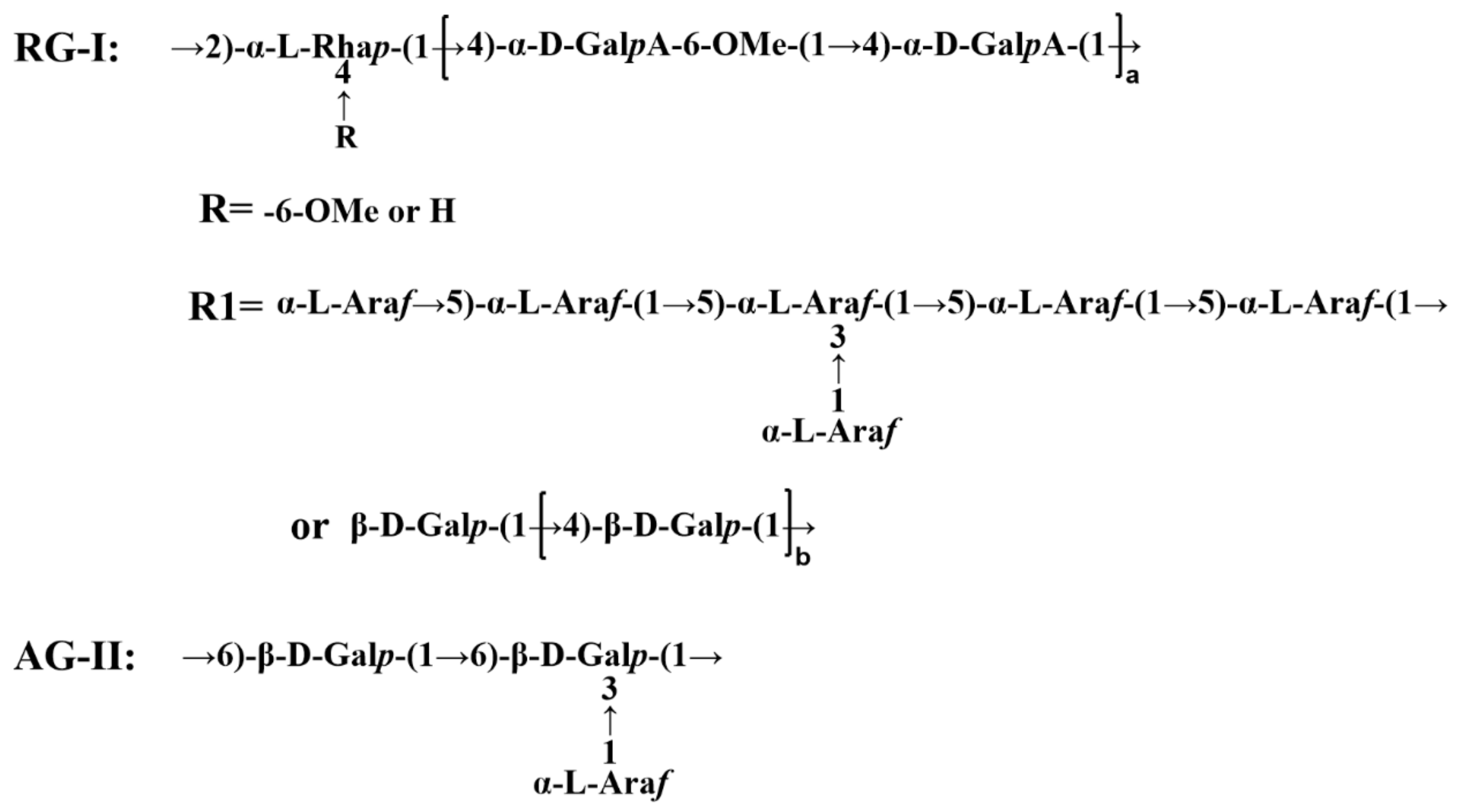
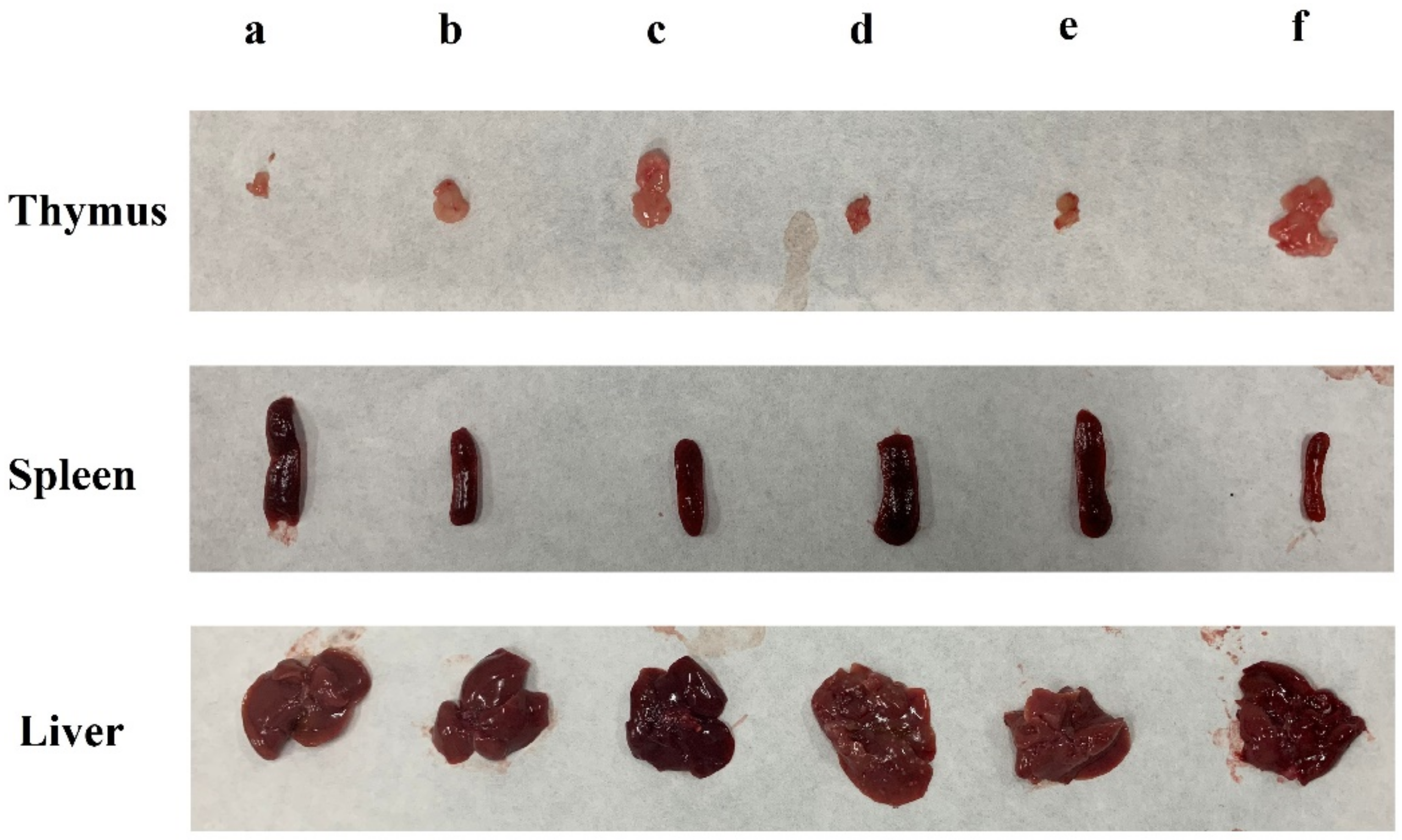
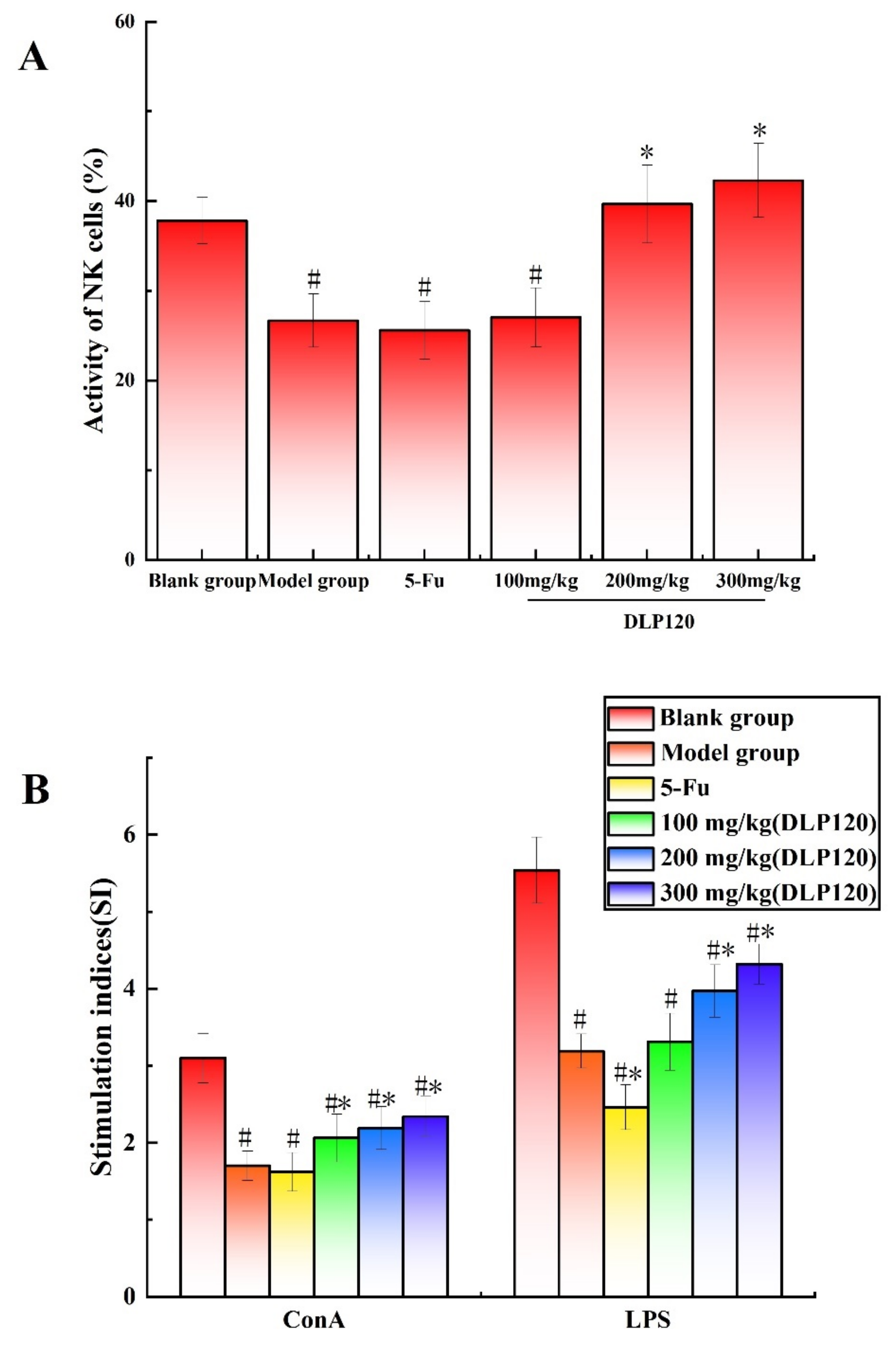

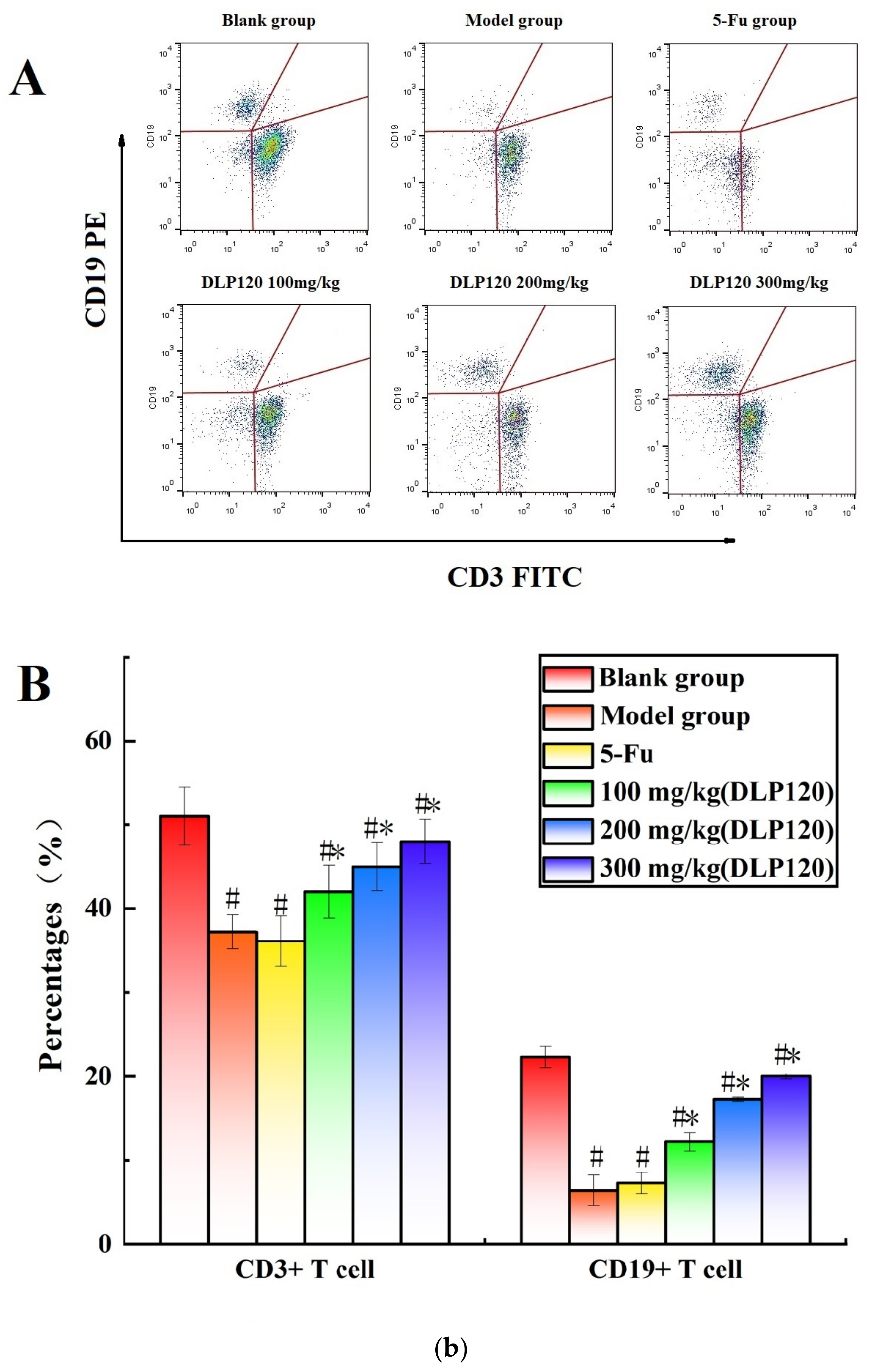
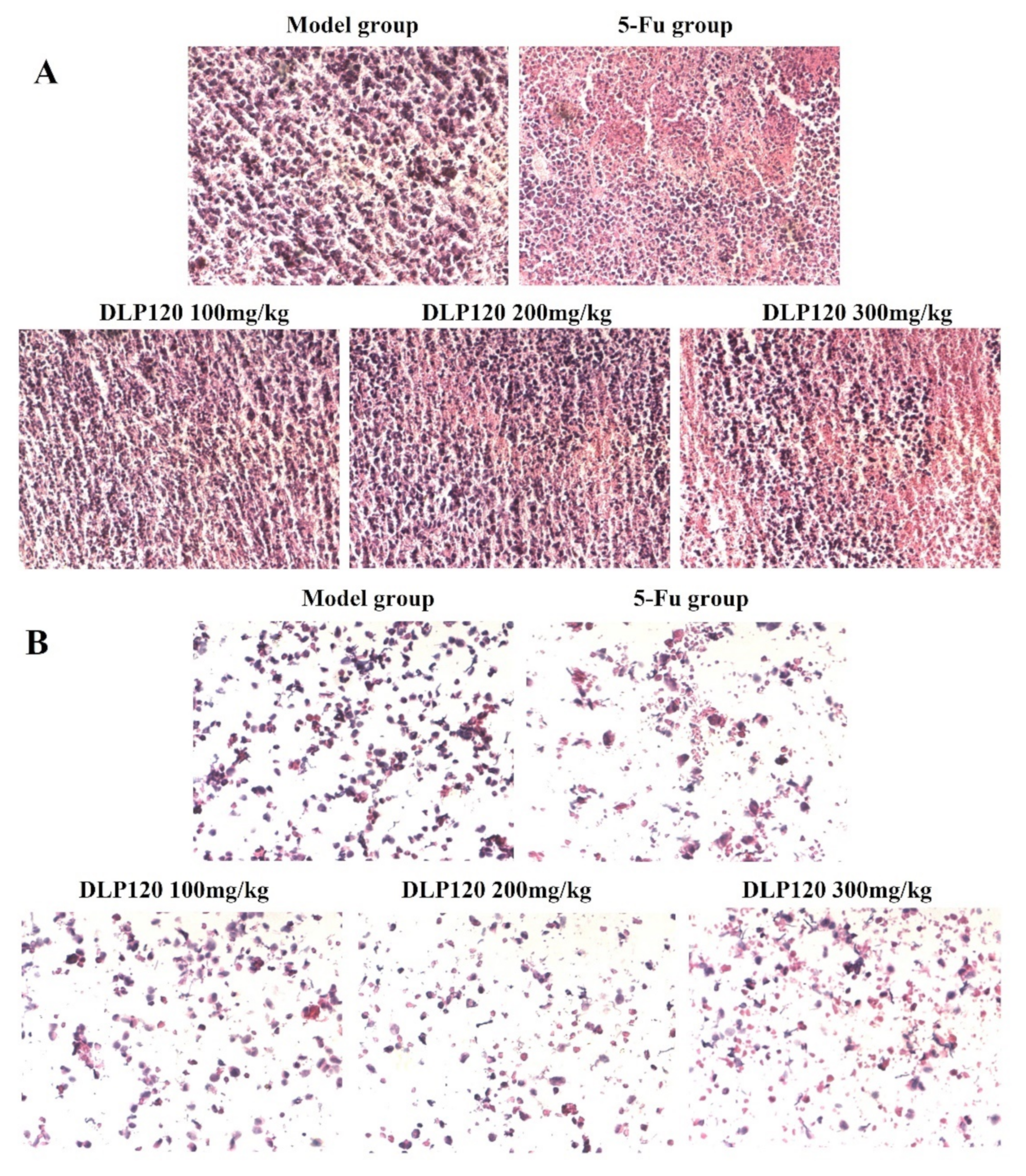
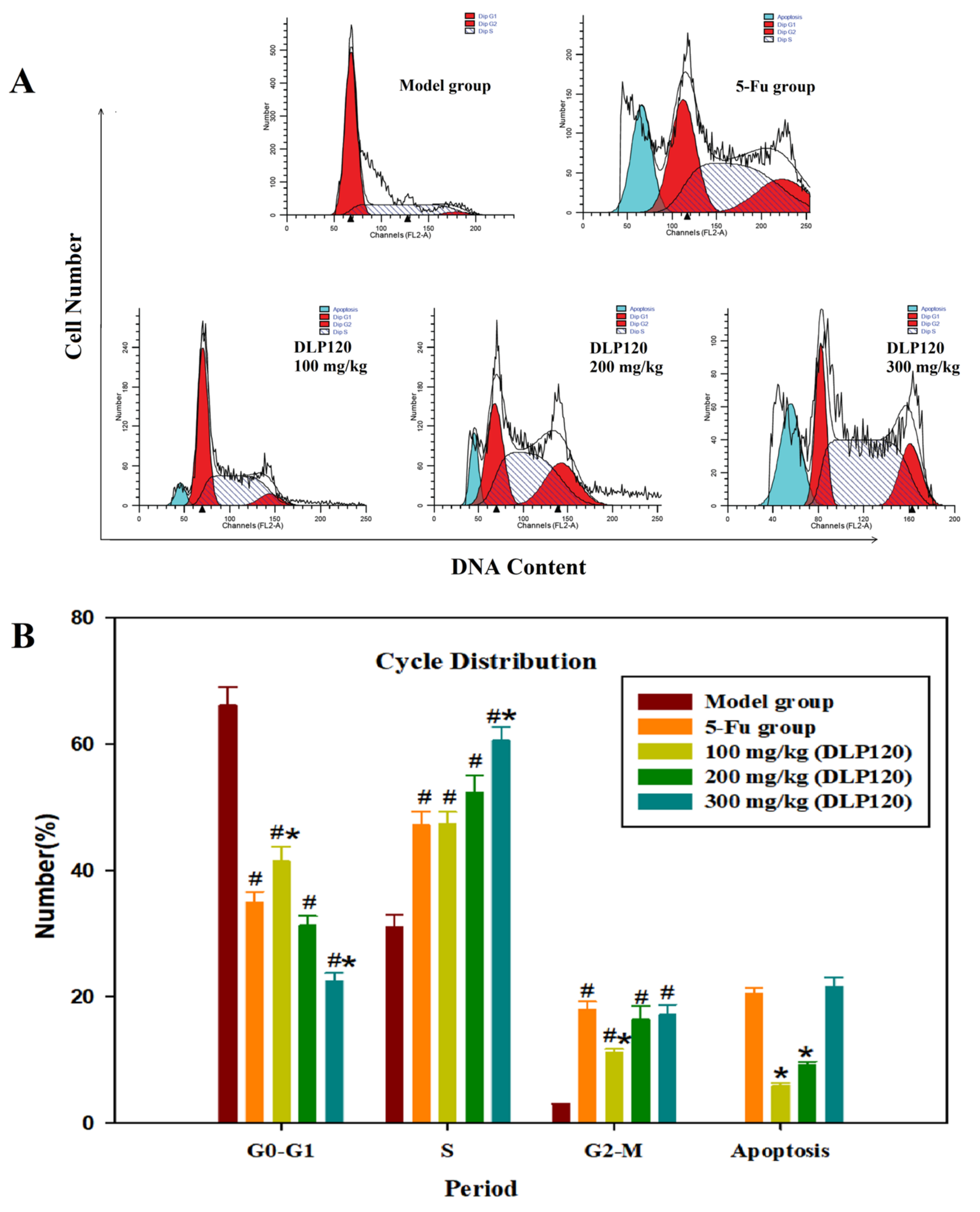

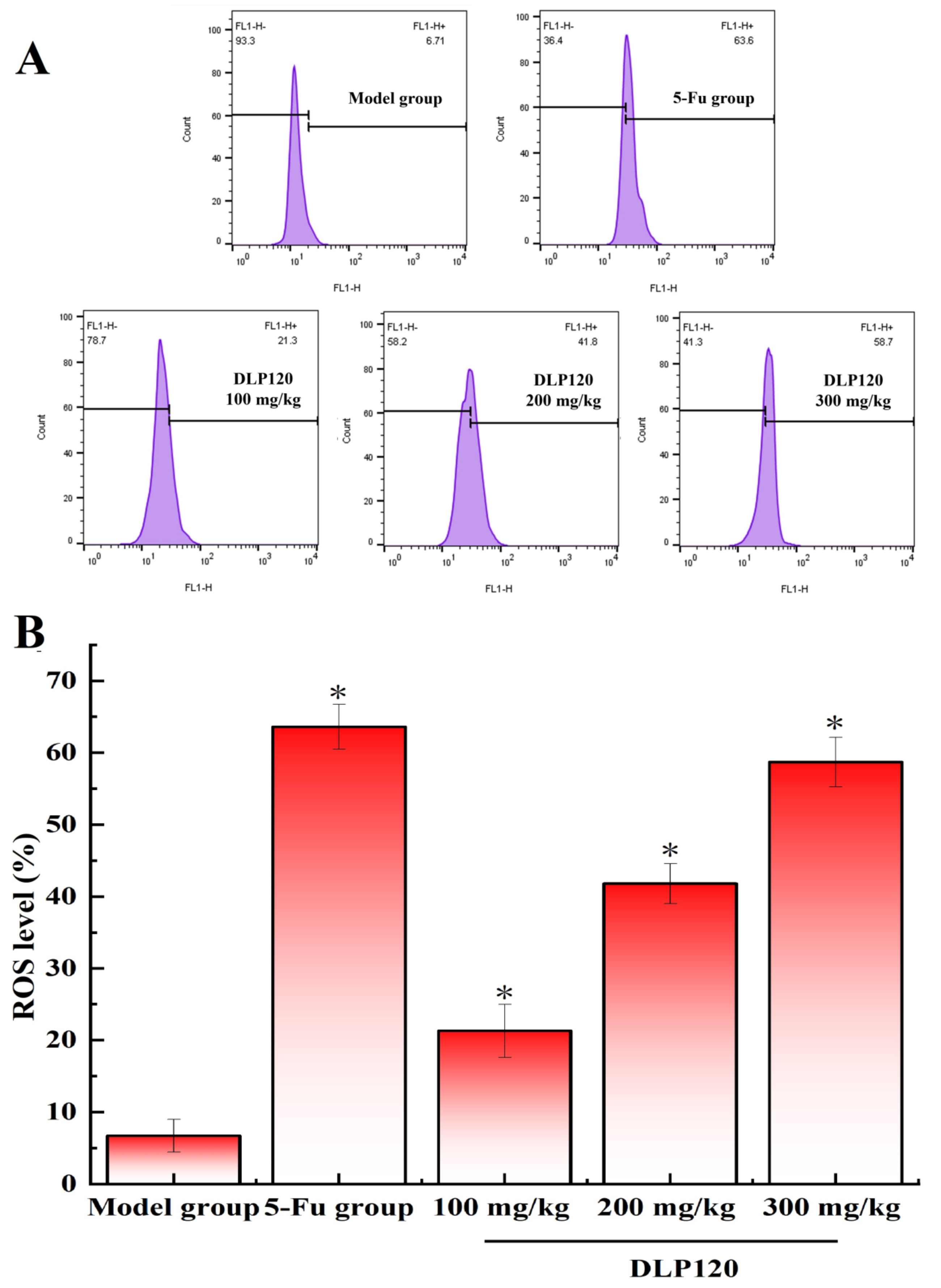
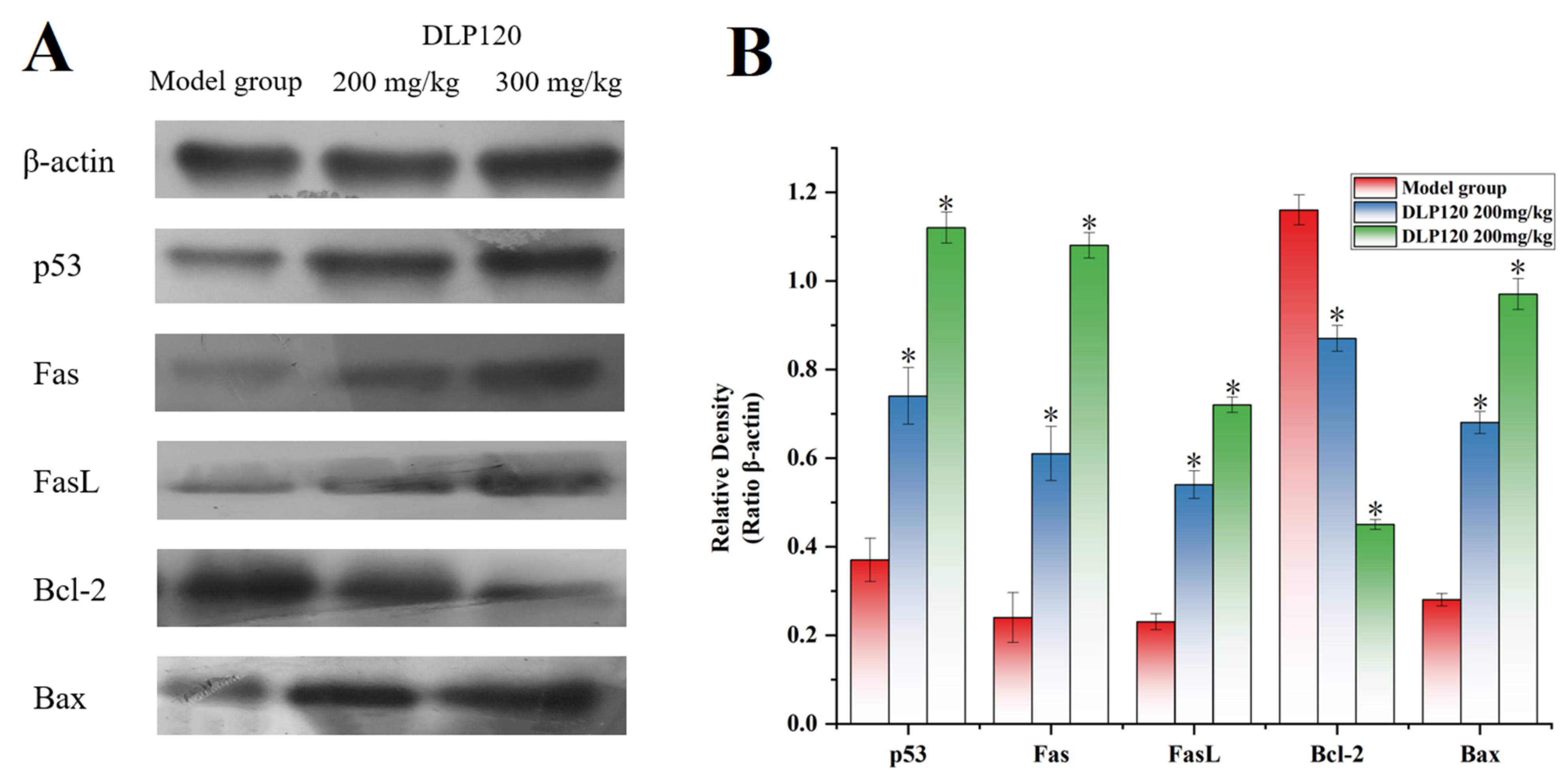
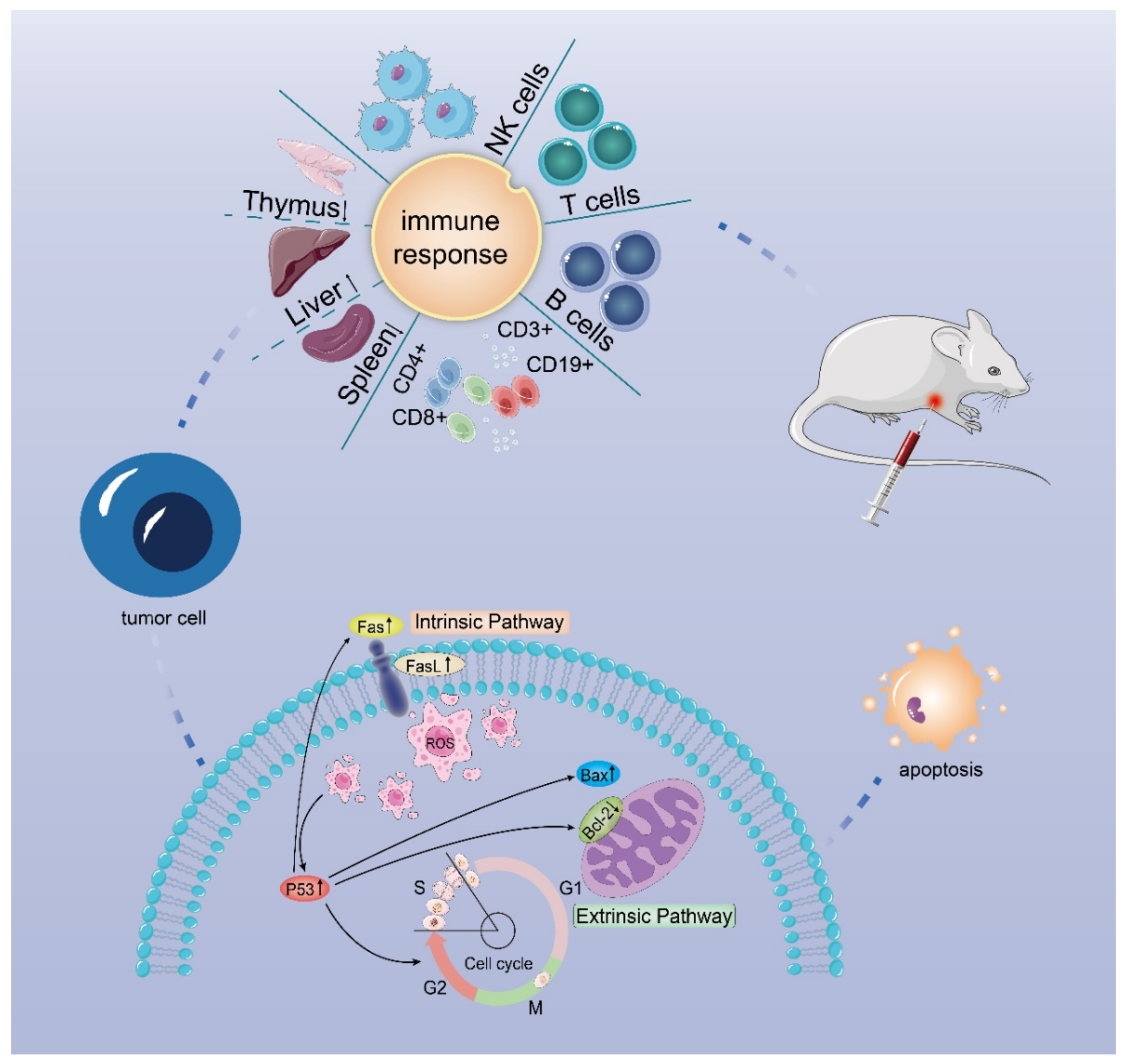
| Groups | Mice Body Weight (g) | Numbers Start/End | Thymus Index (mg/g) | Spleen Index (mg/g) | Liver Index (mg/g) | Tumor Weight(g)/ Tumor Inhibition Rate(%) | |
|---|---|---|---|---|---|---|---|
| Start | End | ||||||
| Blank | 20.32 ± 1.02 | 30.98 ± 1.58 | 10/10 | 3.56 ± 0.31 | 3.30 ± 0.54 | 53.72 ± 4.65 | - |
| Model | 19.87 ± 0.97 | 32.32 ± 1.49 | 10/10 | 1.64 ± 0.56 # | 8.58 ± 1.06 # | 67.06 ± 5.31 # | 3.74/- |
| 5-Fu (20 mg/kg) | 19.56 ± 1.24 | 24.19 ± 0.87 #,* | 10/8 | 2.14 ± 0.37 #,* | 6.79 ± 0.97 #,* | 79.29 ± 6.35 #,* | 1.20/67.95 |
| DLP120 (100 mg/kg) | 20.31 ± 1.05 | 32.16 ± 1.89 | 10/10 | 2.02 ± 0.29 #,* | 8.12 ± 1.24 # | 69.87. ± 6.18 # | 3.04/18.75 |
| DLP120 (200 mg/kg) | 20.63 ± 0.97 | 31.44 ± 1.64 | 10/10 | 3.11 ± 0.41 #,* | 6.42 ± 0.89 #,* | 68.20 ± 5.63 # | 1.89/49.52 |
| DLP120 (300 mg/kg) | 19.74 ± 0.87 | 30.12 ± 1.63 | 10/10 | 3.83 ± 0.59 * | 5.57 ± 1.12 #,* | 67.22 ± 4.51 # | 1.51/59.64 |
Publisher’s Note: MDPI stays neutral with regard to jurisdictional claims in published maps and institutional affiliations. |
© 2022 by the authors. Licensee MDPI, Basel, Switzerland. This article is an open access article distributed under the terms and conditions of the Creative Commons Attribution (CC BY) license (https://creativecommons.org/licenses/by/4.0/).
Share and Cite
Chen, P.; Chen, Y.; Yan, Z.-Q.; Ding, S.-Y.; Liu, H.-P.; Tu, J.-Q.; Zhang, X.-W. Protective Effect of the Polysaccharides from Taraxacum mongolicum Leaf by Modulating the p53 Signaling Pathway in H22 Tumor-Bearing Mice. Foods 2022, 11, 3340. https://doi.org/10.3390/foods11213340
Chen P, Chen Y, Yan Z-Q, Ding S-Y, Liu H-P, Tu J-Q, Zhang X-W. Protective Effect of the Polysaccharides from Taraxacum mongolicum Leaf by Modulating the p53 Signaling Pathway in H22 Tumor-Bearing Mice. Foods. 2022; 11(21):3340. https://doi.org/10.3390/foods11213340
Chicago/Turabian StyleChen, Pei, Yi Chen, Zhi-Qian Yan, Su-Yun Ding, Hui-Ping Liu, Jian-Qiu Tu, and Xiao-Wei Zhang. 2022. "Protective Effect of the Polysaccharides from Taraxacum mongolicum Leaf by Modulating the p53 Signaling Pathway in H22 Tumor-Bearing Mice" Foods 11, no. 21: 3340. https://doi.org/10.3390/foods11213340
APA StyleChen, P., Chen, Y., Yan, Z.-Q., Ding, S.-Y., Liu, H.-P., Tu, J.-Q., & Zhang, X.-W. (2022). Protective Effect of the Polysaccharides from Taraxacum mongolicum Leaf by Modulating the p53 Signaling Pathway in H22 Tumor-Bearing Mice. Foods, 11(21), 3340. https://doi.org/10.3390/foods11213340




